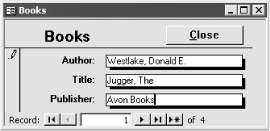Create a Transaction Log
Problem
You want to keep a permanent record of activities in your database. With multiple users simultaneously changing data in your application, how can you keep track of who made which changes?
Solution
Client/server databases such as Microsoft SQL Server offer built-in transaction-logging facilities that provide both a permanent record and a way to recover from disasters by replaying the transaction log. This solution demonstrates a simpler transaction log using Access that tracks users and their edits without saving all the details that would be necessary to recreate the edits entirely.
Start Access and load 10-03.MDB. Open frmBook
and add a few records, update some existing records, and delete some
records. Then review the information in tblLog; you’ll find a
record in this table for each change you made, as shown in Figure 10-15.

Figure 10-15. Examining changed records
To add this simple logging capability to your own database, follow these steps:
Create a new table, tblLog, with the fields shown in Table 10-3.
Table 10-3. Fields in tblLog
Field name
Data type
ActionDate
Date/Time
Action
Number (Byte)
UserName
Text
TableName
Text
RecordPK
Text
Import the module basLogging from
10-03.MDBinto your own database.Add three event procedures to each form for which you wish to track changes. In the sample database, these event properties are attached ...
Get Access Cookbook now with the O’Reilly learning platform.
O’Reilly members experience books, live events, courses curated by job role, and more from O’Reilly and nearly 200 top publishers.

